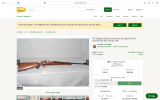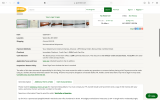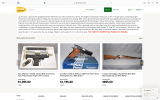Sedgley did re-heat treat all his custom rifles as far as the history shows, with NRA writing an article in 1926 describing that Mr. Sedgley did re-heat treat all actions for which he built guns. (e.g. his name is on the barrel)
The late Michael Petrov, author of Custom Gunmakers of the 20th Century Vol 1&2 wrote this article that goes into a lot of detail on the rifles and references his heat treating of actions.
R. F. Sedgley
Published June 1999
Michael Petrov©
Reginald F. Sedgley started in the firearms business back in 1897 when he was the manager for the Henry M. Kolb gunmaking firm, Sedgley later became the owner in 1916. The business was re-named R.F. Sedgley Inc, at the time they were making the “Baby Hammerless” line of revolvers in caliber .22 & .32 rimfire. The address during this time was 2311 North 16th Street, Philadelphia, and Pennsylvania. The company expanded over the years until they occupied buildings from 2311-17 North 16th Street. As well as the “Baby Hammerless”, Sedgley made police and military equipment in the form of tear gas and flare guns. They made several different products such as a fountain pen gas gun and a .22 conversion for the Colt 1911.
When Sedgley was able to buy low-numbered Springfield actions from the government at what I would imagine would be next-to-nothing prices the idea of a semi-custom sporter took shape. These actions were inspected, annealed, had the markings ground off then re-heat treated and proof tested to 80,000 psi. This re-heat treating service was also offered to members of the NRA who could have their low number gun inspected for free.
A typical Sedgley sporter was made on a Springfield action in caliber .30-06 with a 26” barrel that was made by Winchester. The stock was without cheek piece and made from imported walnut. If you wanted a cheek piece you had to order a better grade of wood that ran from 15 to 30 dollars more; they would not build a rifle with a cheek piece using their plain wood. The stock had a Schnabel fore-end, Winchester steel buttplate, hard rubber pistol grip cap and barrel band sling swivel that went through the stock. The pistol grip and fore-end as well as a small section to the rear of the tang was checkered. All Sedgleys that I have examined show above average inletting and checkering. Sighting equipment was a Lyman 48-receiver sight and a banded ramp front sight with gold or ivory bead. The receiver ring where the serial number had been removed was matted to cut down on glare. The gun was hot blued and the color is a shinny blue that is, in my opinion, not as attractive as rust blue found on most custom sporters of the day.
The Low Numbered Springfield: The first 800,000 Springfield Armory and 285,507 Rock Island Arsenal rifles were made from Armory Class-C steel and were heat treated the same as the Krag rifles before them. The receivers were case hardened. What this means is that the action was very hard on the surface with a softer core. This was supposed to result in a very strong action that had excellent resistance to surface ware and retained a non-brittle interior core. At the armory the new rifles were proof tested to 70,000 lb. The first cartridge for the 1903 Springfield was the 30 Government Model 1903, this was re-designed in 1906 by shortening the case neck by .070”. The first 269,000 rifles had the barrel set back .200” and re-chambered and re-proofed. After 700,000 rifles and fourteen years of trouble-free service several things happened that would doom the low numbered Springfield for all time. Production was stepped up at the Armory during wartime and an unknown number of actions were over hardened (this is sometimes referred to as “Burnt Steel”) and instead of being only surface hardened they were hard all the way through. This resulted in an extremely brittle receiver and I am amazed that any could pass proof testing. About this same time riflemen were trying to find a way to cut down on metal fouling in the bore caused by cupro-nickel bullets. It was found that if you coated your bullets after they were loaded with a grease called Mobilubricant made by Vacuum Oil Company, accuracy improved, barrel life increased and fouling was cut way down. As you can imagine it was not long before the entire cartridge case and chamber wall were coated with grease. A greased chamber increased the backward thrust on the bolt resulting in accelerated headspace problems. As the war progressed several different companies started making brass that was later found to have been improperly annealed. All that was needed for disaster was some excess headspace and instead of a case separation and maybe a splintered stock you had a Model 1903 hand grenade. I know of no recorded fatalities but there were enough serious injures that the heat-treating was changed to a double heat-treat, then later Springfield and Rock Island went to a nickel steel receiver. Springfield Armory double heat treat numbers are from 800,000-1,275,767 at which time they switched to nickel steel. At Rock Island Arsenal the double heat-treat numbers were 285,507-319,921 then they too switched to nickel steel. If you sent your low-numbered Springfield back to the Armory for a new barrel the receiver would also be replaced. This went on for a while but after many complaints from rifleman who did not want their smooth (hard) actions replaced this practice was stopped. If you wanted your receiver replaced you had to ask for it. The NRA reported in 1936 that Sedgley had re-heat treated thousands of these low number actions.
The first ads found for the Sedgley-Springfield sporter appear in 1929. Along with the standard sporter at $65 they introduced a left-hand conversion for $125 and a full stocked Mannlicher type sporter that sold for $100.
Sedgley would remodel any rifle that you sent them. I have seen Sedgley barrels on Mannlicher Schoenauer, Enfield, Winchester 54, Remington Model 30, Mauser and about every single-shot action you can think of. One of their better conversions was on the Winchester Model 1885 single-shot, better known as the Hi-Wall. These were made in caliber .22 LR and .22 Hornet and sold for $71. Sedgley bought up the last of the actions (reportedly 200) from Winchester and made a nice looking and shooting rifle that is very sought-after today. The Sedgley Hi-wall was introduced in 1932. Another Sedgley prize is the shortened 1903 Springfield action made for the .22 Hornet, introduced in 1934 at cost of $105. This shortened rifle was advertised in several calibers but I only know of examples in .22 Hornet and at least one in .218 Bee. These had about one inch removed from the action, bolt, and floorplate, then were rewelded and hardened. These rifles are compact and attractive. A Sedgley innovation was their Springfield Safety Firing Pin and Speed Lock. This was a sleeved firing pin with a “U” locking ring which prevented the cocking rod from leaving the bolt in case of a broken rod or firing pin. In conjunction with this work a hole was drilled in the bottom of the bolt for escaping gas. The Speed Lock was made by using a longer firing pin, which Sedgley claimed increased lock time by 40%. Cost of the Safety Lock was $1.50 and Speed Ignition $5. These rifles equipped with the Speed Locks are easily recognized when looking at the cocking piece. It sticks out ¼” in the fired position. Sedgley also made sporters on the Krag action, offering them in .30-40 Krag for $60 or .25-35 WCF & .250-3000 for $65.
Sedgley offered hunting telescopes made by Nosk, Zeiss, Hensoldt and The Lyman Alaskan when it was introduced. The only mounting system listed in their catalogs was the Griffin & Howe side mount. I have seen a couple of sporters with a rib and express sights. At least twelve Springfield rifles that were made for the Denver Police Department have open (look like Winchester to me) barrel mounted sights. I’m not sure what the Denver police had these rifles made for but when ten of them were sold in 1989 they were still like new. These Denver guns are stamped just in front of the receiver on the barrel “D.P.D.”; three that I have information on are serial numbered 1140, 1149 and 1152.
In 1931 Sedgley introduced their De Luxe Model Springfield Sporter. Catalog description is “Circassian walnut stock with cheek piece and finely checkered Pistol Grip and Fore-end, Buffalo horn tip, Engraved trap buttplate and engraved steel pistol grip cap. Fine line engraving on barrel, breech, and muzzle, also on trigger guard and floor plate with hunting scene, checkered bolt knob and chromium plated bolt.” These sold for $150 In 1932. I suspect the reason these are rarely ever encountered is because if you had $150 to spend on a rifle in 1932 you went to Griffin & Howe, Hoffman Arms or another custom maker. The scroll work is a little big for my taste and the pictured De Luxe has an animal on the floorplate that can best be described as a puppy dog with antlers. Typical engraving looks to be from the “American Stick Figure School of Engraving”.
Their only proprietary cartridge that I know of is the .22-4000 Schnerring-Sedgley, a .257 Roberts (7x57mm) necked to .22 shooting a 46-grain Skisk bullet at 4012 fps. Sedgley offered about every modern chambering then available from the .22 Rim-Fire to the .505 in a Magnum Mauser action but 90% or more are the .30-06.
On March 29, 1938 R.F. Sedgley died. The business continued under the leadership of H.E. Manning, President and A.W. Gregory, Sales Manager. When WW II started the company was involved in war work as were all gun makers of the day. For someone inclined to do the research I think that you would find a connection between the OSS and Sedgley in regard to special weapons. The remaining inventory of Springfield parts and pieces were used up in making 1903 Springfield rifles for guard and plant protection. When the end of the war came there was little material or work for Sedgleys and they closed. Some workmen went on to establish themselves as custom rifle makers. The best known was Paul Jaeger of Jenkintown, Pennsylvania who had learned the gun trade in Germany. Martin Wurzer, a Ferlach-trained metal man and Carl Peterson a Swedish-trained stockmaker, formed the partnership of Wurzer & Peterson in 1945 this located at 5239 N. Fifth St. Philadelphia.
Identifying a Sedgley:
All Sedgleys are marked on the barrel with a one line name and address “R. F. Sedgley Inc. Phila, PA USA”. On the barrel near the receiver is the caliber marking “CAL 30:06” and the Sedgley proof mark is an “S” inside of a circle. The Sedgley serial number on the Springfields is located on the back of the bolt handle and in the bottom of the upper tang. On Sedgley-Springfields that still have the number on the receiver there is no Sedgley serial number. Most of the Sedgleys with the Arsenal number not removed are Rock Island made actions, why these were not ground off I have no idea. About 1/3 of the Sedgleys I have looked at have no Sedgley serial number and the highest Sedgley number logged so far is 1729 * 2008 phone call. Sedgley rifles will also have what I call an assembly number found on most major parts and the stock. These will be a 2,3, or 4-digit number in no sequence. As a matter of fact I have seen the same number repeated on different rifles.
The Sedgley sporting Springfield has always been a bargain, as much today as when it was new. Sometimes referred to as the “Working Man’s G&H”, when first introduced at $65 they had a wide following and it was not until I started putting numbers together that I realized they were made for only about 12 years.
I have owned and shot several Sedgley Springfields over the years and never found one with headspace problems or anything else seriously wrong with it. I have not found a report of a single failure of an unmodified Sedgley-Springfield. In the American Rifleman June 1947 there is a picture and a report of a Sedgley-Springfield with a penny size chunk blown out of the top of the receiver. Investigation revealed that the gun had been rebarreled, four holes had been drilled all the way through the receiver ring to mount a scope and the pressure of the fired cartridge was in excess of 100,000 pounds. If you know of ANY Sedgley failures please let me know.
There seem to be two camps when it comes to the Sedgley sporters. In one camp the Sedgley-Springfields live under the black cloud of the low-number Springfields. At times I see these for sale at a price that would not buy a gunstock blank of the wood that it’s stocked with. In the other camp these are prized rifles and will be passed on to the next generation.



